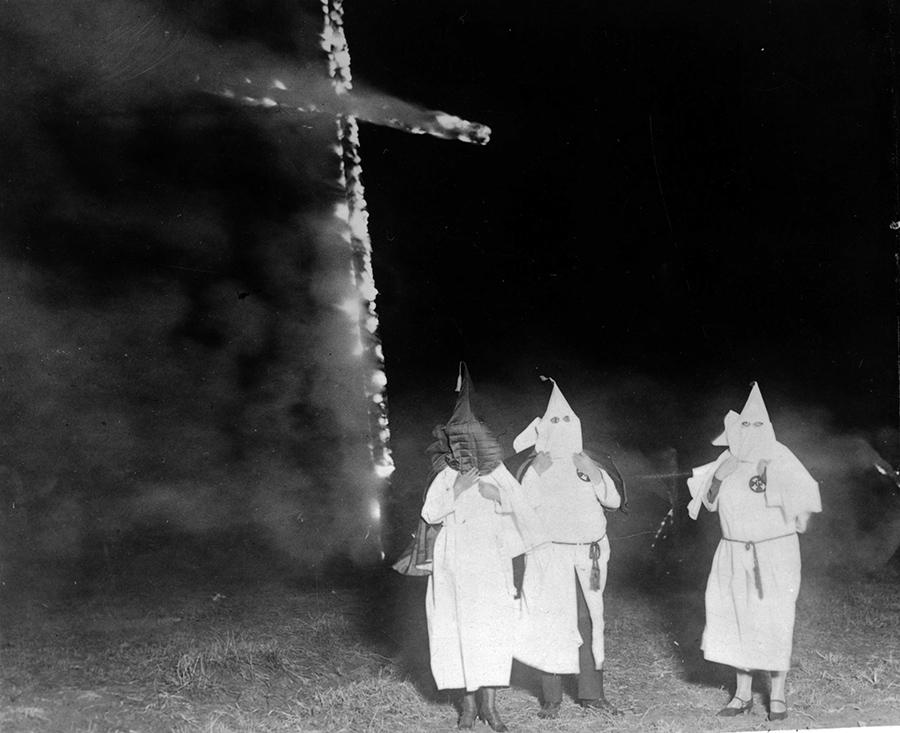Ku Klux Klan in Colorado
Full Article
The Ku Klux Klan (KKK) is an American white supremacist and terrorist organization whose history includes two distinct waves of activity. The first KKK was created in Tennessee in 1866 and was not active in Colorado. A chapter was not established in the Centennial State until 1915, after the group’s second nationwide establishment. By the mid-1920s, the KKK had risen to power in Colorado, where it gained control of the state legislature, the governor’s office, the Denver mayor’s office, the Denver police department, and many members of the statewide Protestant community. The KKK did this by exploiting local ethnic divisions and prejudice with its message of “100% Americanism.”
Today, the Colorado Klan’s influence is significantly diminished, but its ideology of race- and religious-based prejudice lives on in its small remnant factions and in other hate groups throughout the state.
Origins
The first KKK was founded in 1866 as a social club in Pulaski, Tennessee. Many members of the original organization were former Confederate Army veterans. That summer, local chapters gathered and established the Invisible Empire of the South, electing Nathan Bedford Forrest as the Grand Wizard of all Klan chapters. The Klan during this time was active mostly in the Reconstruction-era South, when all states were forced to ratify the Thirteenth, Fourteenth, and Fifteenth amendments to the US Constitution. The Klan vehemently opposed the fundamental idea of these amendments, which was that the millions of formerly enslaved African Americans deserved citizenship and voting rights. The Klan violently resisted the enforcement of these amendments, by targeting mostly black southerners as well as white Republicans. The increase in violence prompted Congress to pass three Enforcement Acts, including the Ku Klux Klan Act of 1871, all designed to make the types of hate crimes committed by the KKK federal offenses. President Ulysses S. Grant eventually suspended Habeas Corpus to defeat the first iteration of the Klan.
The second formation of the KKK came around 1915, when a group of white Protestant nativists led by William Joseph Simmons reestablished a chapter in Atlanta, Georgia. This new KKK was different from its predecessor in that it was not only antiblack, but also anti-Catholic and anti-Semitic. It stood against immigrants and minorities as well as organized labor. Klan membership peaked in the 1920s, with national membership exceeding 4 million people.
Rise and Fall in Colorado
Seeing themselves as saviors of “Americanism” and the “Old-Time Religion,” twentieth-century Klan members felt it was their duty to protect Protestant ideals. This ideology resonated with the fundamentalist faction of Colorado Protestants. By 1925 the KKK Colorado Realm was at peak membership and was led by Grand Dragon Dr. John Galen Locke. Major Colorado towns such as Denver, Grand Junction, Pueblo, and Cañon City were hotbeds of Klan activity. The KKK in Colorado was popular not only for its racist ideologies but also for its community events—evangelical Protestants saw the KKK as similar to other social organizations, like the Elk Lodge. A variety of local Klan events, including auto races and picnics, drew up to 10,000 people.
The Klan in Colorado peaked in 1925. By this time, it had infiltrated all levels of the state government. The Klan controlled many members of the legislature, held the State Supreme Court judgeship and seven benches on the Denver District Courts, and had controlling majorities in some town councils. Some of the most notable Klansmen at the time included Denver mayor Ben Stapleton, Denver police chief William Candlish, and Colorado governor Clarence Morley.
During its peak in Colorado, the KKK had both male and female chapters (Women of the KKK) and led boycotts of many local businesses run by Jews, blacks, and other minorities. In some cases, boycotts escalated to physical violence and other acts of aggression against minorities. Dr. Clarence Holmes, President of the Denver NAACP, received a threatening letter and found a burning cross outside of his house in response to his efforts to integrate the city.
After reaching peak membership in 1925, the Klan began to decline in Colorado. Although it had infiltrated the state government at all levels, there were a few key government figures, such as district attorney Philip Van Cise, and state judge Ben B. Lindsey, who opposed and actively fought the Klan’s political control and influence. Due to the efforts of Van Cise, Lindsey, and others, the Colorado Grand Dragon, Dr. John Galen Locke, was investigated for tax evasion. This investigation led to a slew of corruption scandals involving other Klansmen, severely weakening the Klan’s position in the state. Membership declined, mirroring a national trend, and the Klan diminished into political obscurity.
Despite its lack of influence, the Klan remained active in Colorado throughout the twentieth century. In the late 1970s, Colorado Springs police sergeant Ron Stallworth infiltrated the local KKK chapter. Stallworth, who is black, spoke to multiple Klansmen on the phone, including David Duke, then Grand Wizard of the nationwide Invisible Empire of the KKK. Stallworth sent a white officer to in-person meetings with local Klansmen, who included a soldier stationed at nearby Fort Carson and high-ranking employees of the NORAD facility under Cheyenne Mountain. When the US military learned, through Stallworth, of the high-ranking NORAD Klansmen, it neither identified nor discharged them, but instead relocated them to the most northern US base in the world.
The KKK continues to operate in Colorado today, though it does not enjoy as broad an influence or membership as it once did. The Southern Poverty Law Center, an organization that tracks hate group activity throughout the United States, lists both a statewide KKK as well as a local hub in Grand Junction. While the KKK itself may not be widespread in Colorado today, its ideology and tactics live on in many of the state’s twenty-one hate groups reported in 2017.


